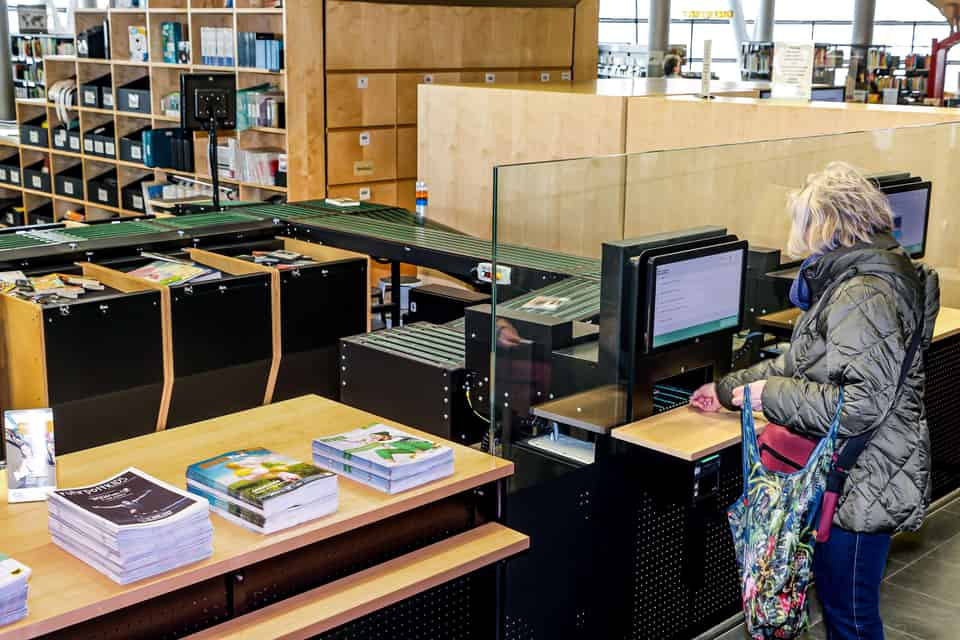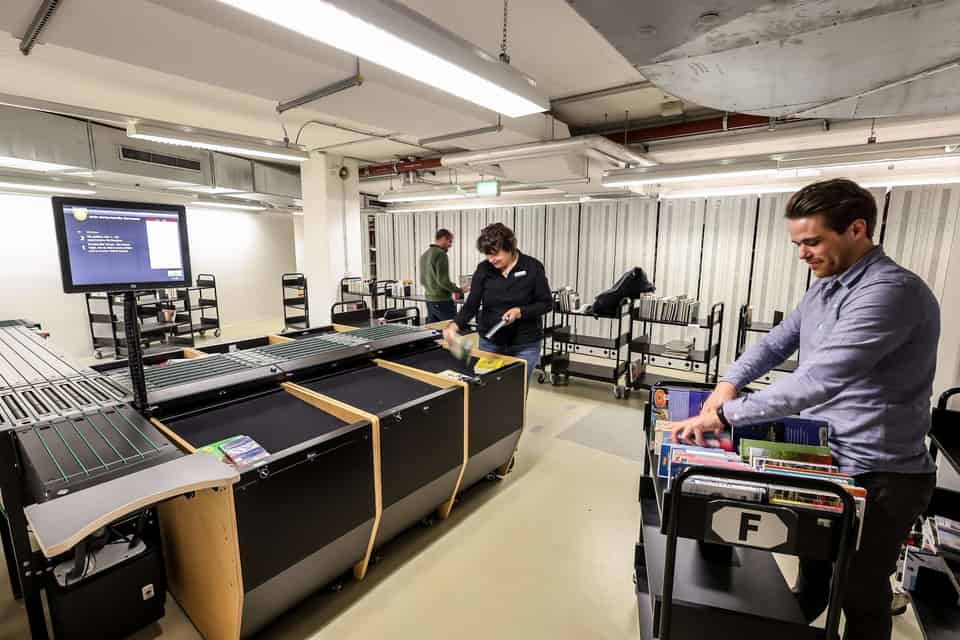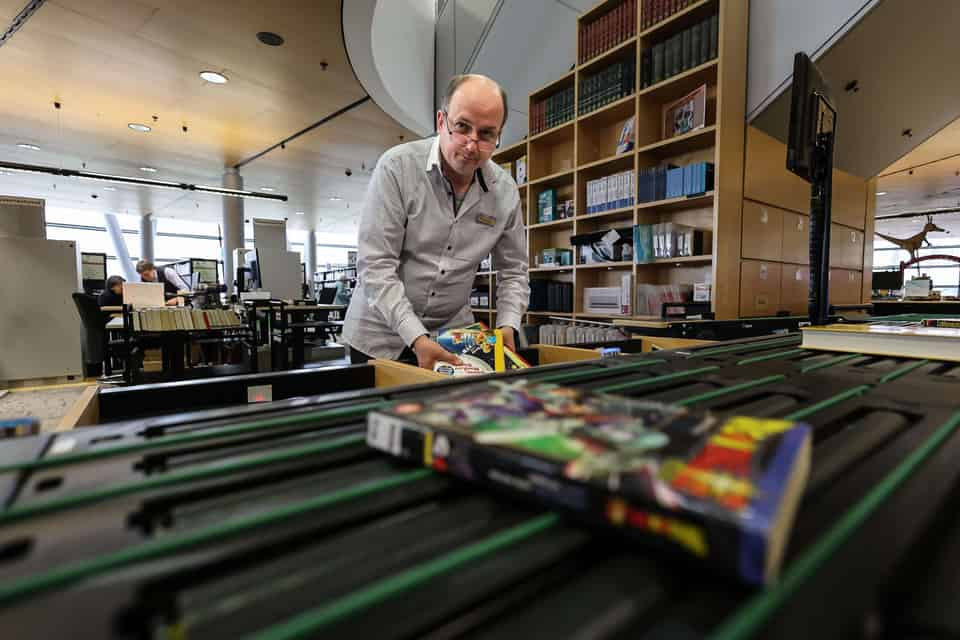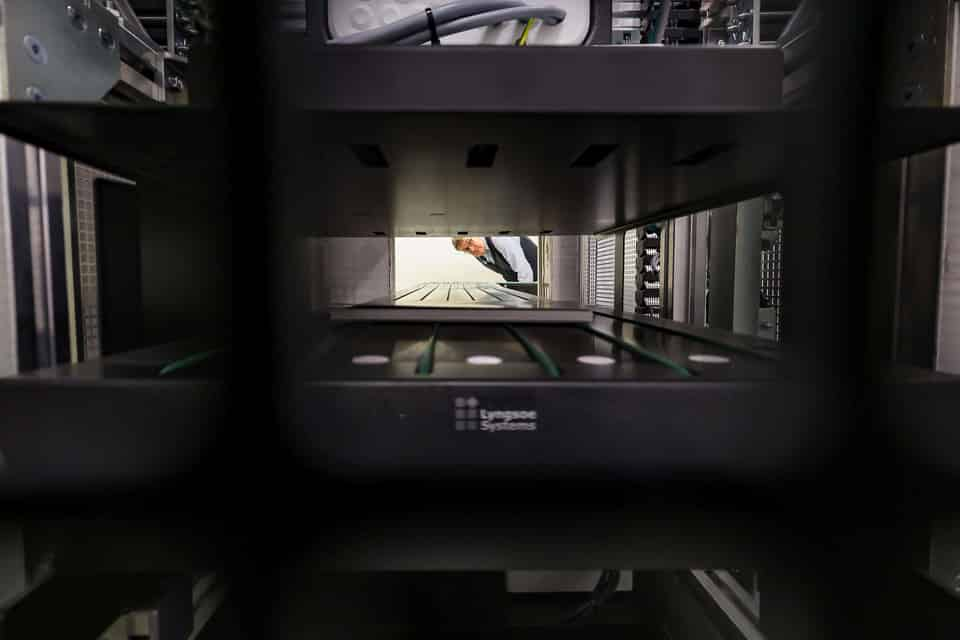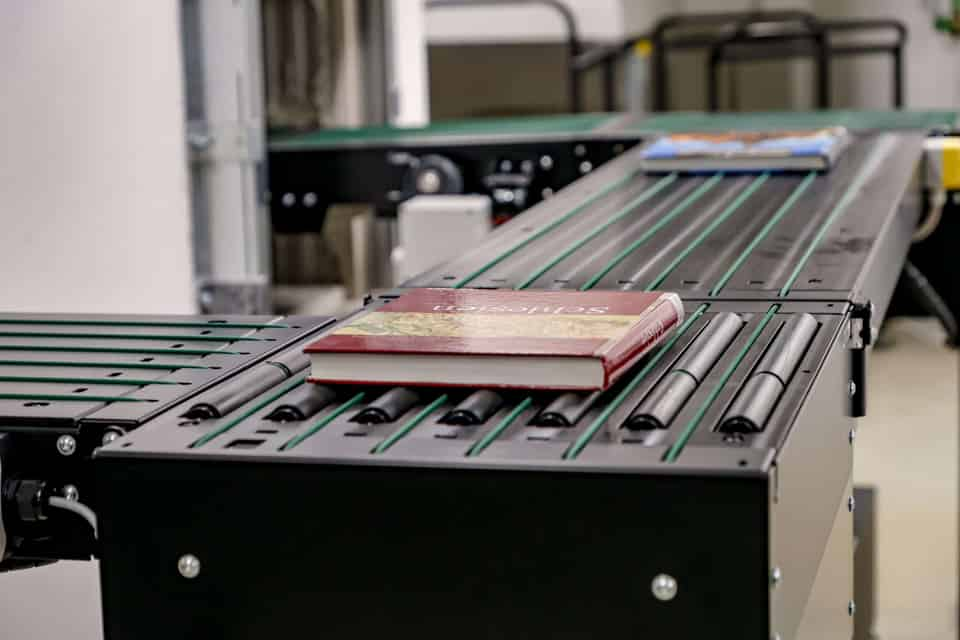Fallstudien: Zentralbibliothek der Stadt- und Landesbibliothek Dortmund
Automatische Buchrückgabe In der Zentralbibliothek
“Die neue Rückgabeanlage fügt sich sehr gut in die anspruchsvolle Architektur unserer Bibliothek ein und stellt damit nicht nur funktional sondern auch optisch eine echte Bereicherung für unser Haus da.”
Markus Lohmann
Leiter der Zentralbibliothek
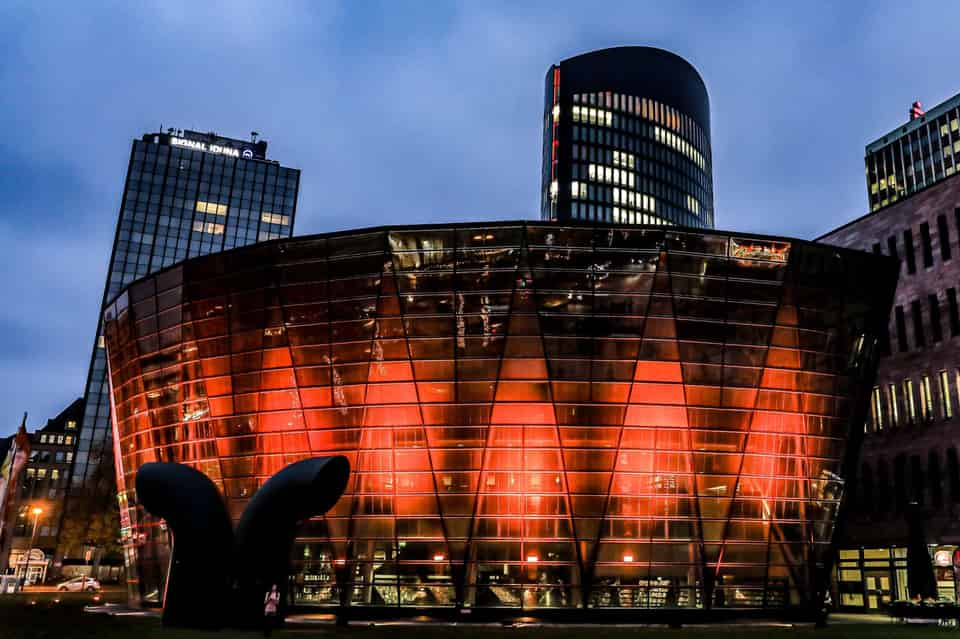
Ausgangslage und problemstellung
Die Zentralbibliothek der Stadt- und Landesbiblio¬thek Dortmund wurde von dem italienischen Archi¬tekten Mario Botta in den 1990er Jahren geplant und errichtet. Das gegenüber dem Hauptbahnhof liegende architektonisch herausragende Gebäude wurde 1999 von der Bibliothek bezogen und emp¬fängt seitdem täglich ca. 2000 Besucher:innen. Die Buchrückgabe erfolgte bisher noch händisch durch Personal an der im Eingangsbereich der Bibliothek gelegenen Rückgabetheke. Die Medien wurden von hier mit einer Wannentransportanlage in den Keller transportiert und hier ebenfalls händisch auf die Ein¬stellwagen sortiert.
Durch den vom Ministerium für Kultur und Wissen¬schaft NRW geförderten Einbau einer automatisier¬ten Rückgabeanlage sollte die Rückgabe in Selbst¬bedienung ermöglicht werden. Die Anlage sollte sich dabei möglichst harmonisch in die Architektur von Mario Botta einfügen und die Eingriffe in die Gestaltung des Thekenbereiches im Erdgeschoss möglichst klein sein. Dabei sollte sie in Hinblick auf Funktionalität und Ergonomie sowohl für die Kun¬dinnen und Kunden der Bibliothek als auch für die Beschäftigten höchste Standards erfüllen.
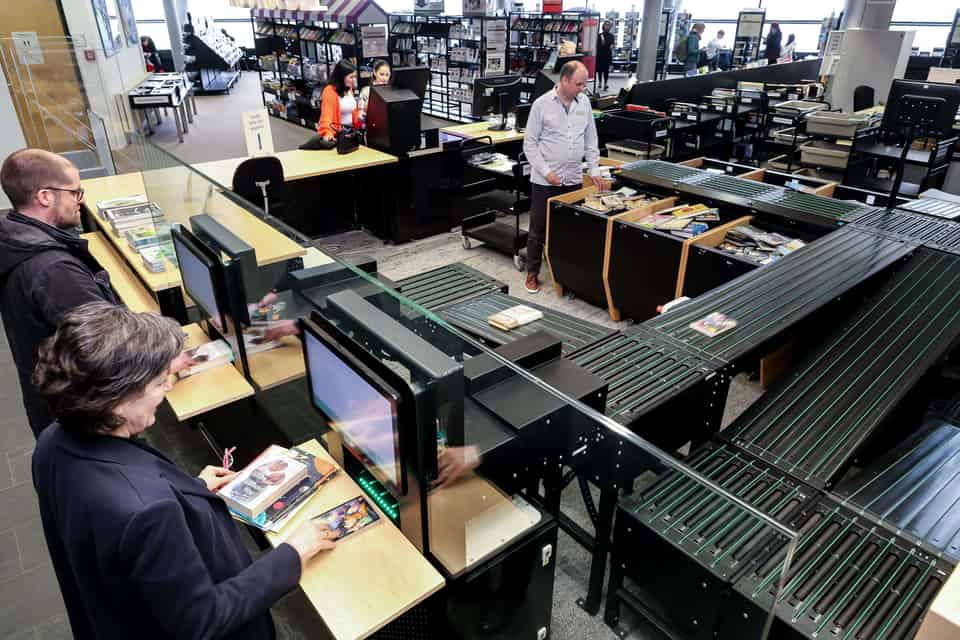
Rückgabeanlage - planung und umsetzung
Während der Planungsphase der Rückgabeanlage mit der das Büro leistungsphase.architekturbüro – silge.werner.architekten PartGmbB aus Nordkirchen beauftragt war, wurde schnell deutlich, dass die räumlichen Verhältnisse im Erdgeschoss eine vollständige Realisierung der Anlage in diesem Bereich nicht zulassen. Daher war es notwendig auch mit der neuen Anlage Medien durch den vorhandenen Aufzugsschacht in das Kellergeschoss zu transportieren, um dort einen Teil der Sortieranlage zu platzieren. Nach einer Analyse der Zusammensetzung der zurückgegebenen Medien nach den verschiedenen Standorten wurde eine Anlage mit 12 Sortierzielen auf zwei Ebenen geplant. Dabei verbleiben die Medien mit einem Standort im Erdgeschoss bei der Sortierung auf dieser Ebene, während die Medien mit Standorten in den anderen Geschossen mittels eines Vertikaltransportes in das Kellergeschoss gebracht und dort sortiert werden. Außerdem sollte auch ein Rücktransport von Medien aus dem Kellergeschoss ins Erdgeschoss möglich sein.
Um die Raumwirkung im Eingangsbereich der Bibliothek möglichst wenig zu beeinträchtigen, wurde geplant, die Anlage frei hinter den vorhandenen Theken zu platzieren, und die Rückgabeautomaten in eine gläserne Wand zu integrieren. Außerdem sollte der Aufzug mit seinem Überbau eine Höhe von ca. 2m nicht überschreiten. Durch die freie Aufstellung der Anlage im Publikumsbereich spielte die Geräuschentwicklung während des Betriebes bei der Ausschreibung eine wichtige Rolle. Außerdem sollte sich die Anlage auch optisch gut in die vorhandene Gestaltung einfügen.
Als Ergebnis des Vergabeverfahrens bekam die Firma Lyngsoe den Auftrag zum Einbau einer Rückgabeanlage. Die Anlage erfüllte alle geforderten Voraussetzungen in Hinsicht auf Funktionalität und Ergonomie und stellte zugleich auch die wirtschaftlichste Lösung da. Durch den Einsatz von Schrägtransportbändern konnte die geforderte Höhe für den Überbau des Aufzuges erreicht und die Anlage im Erdgeschoss zugleich so platziert werden, dass eine gute Erreichbarkeit aller Sortierziele auch mit Bücherwagen möglich ist.
Hierdurch und durch die ergonomisch optimierten Sammelbehälter und Bedienstationen, werden für die in diesem Bereich beschäftigten Bibliotheksmitarbeiter:innen sehr gute Arbeitsbedingungen ermöglicht. Auch in Bezug auf Optik und Geräuschentwicklung erfüllte die angebotene Anlage die hohen Anforderungen der Planung.
‘’Durch die ergonomisch optimierten Sammelbehälter und Bedienstationen, werden für die Bibliotheksmit-arbeiter:innen sehr gute Arbeitsbedingungen ermöglicht. Auch in Bezug auf Optik und Geräuschentwicklung erfüllte die Anlage die hohen Anforderungen unserer Planu.’’
Johannes Borbach-Jaene
Kulturbetriebe Dortmund Stellvertreter des geschäftsführenden Direktors Geschäftsbereichsleiter Bibliotheken Direktor der Stadt- und Landesbibliothek
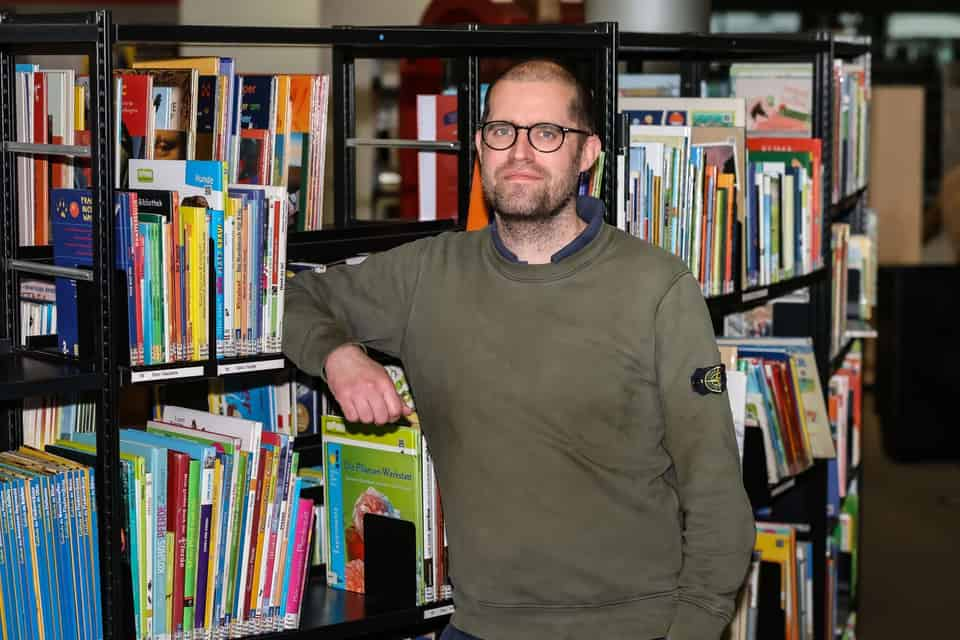
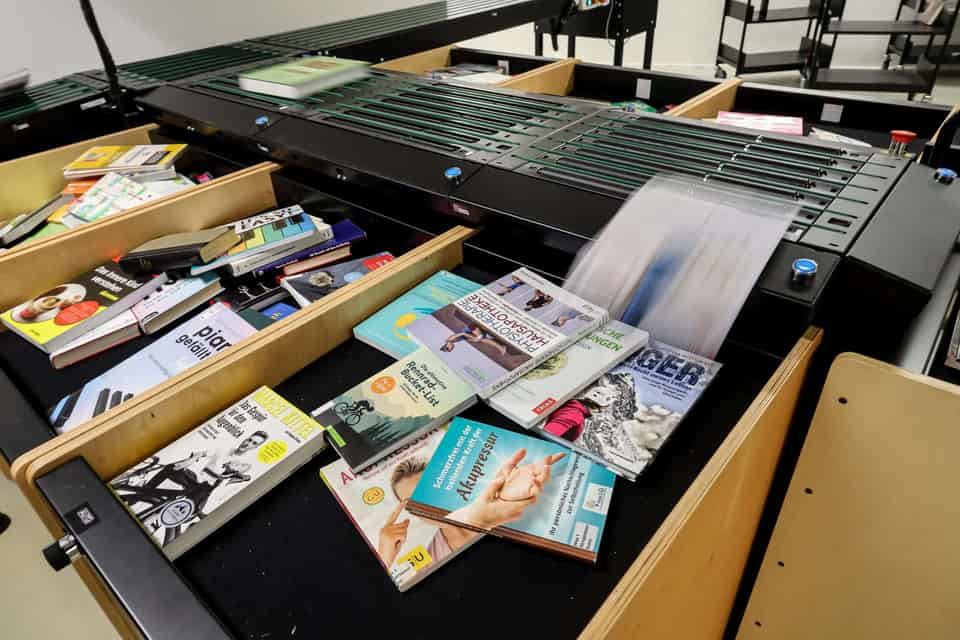
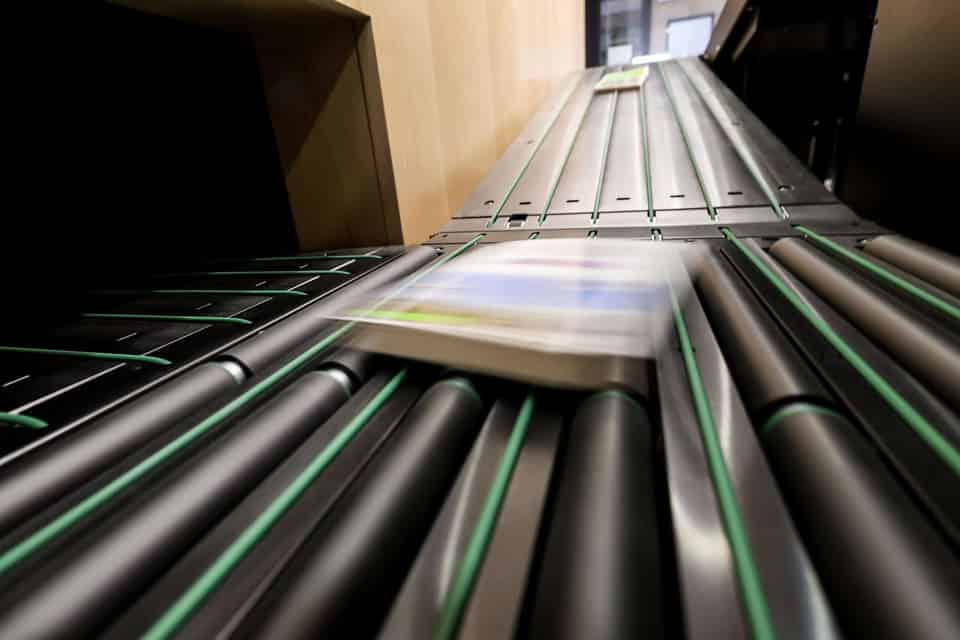
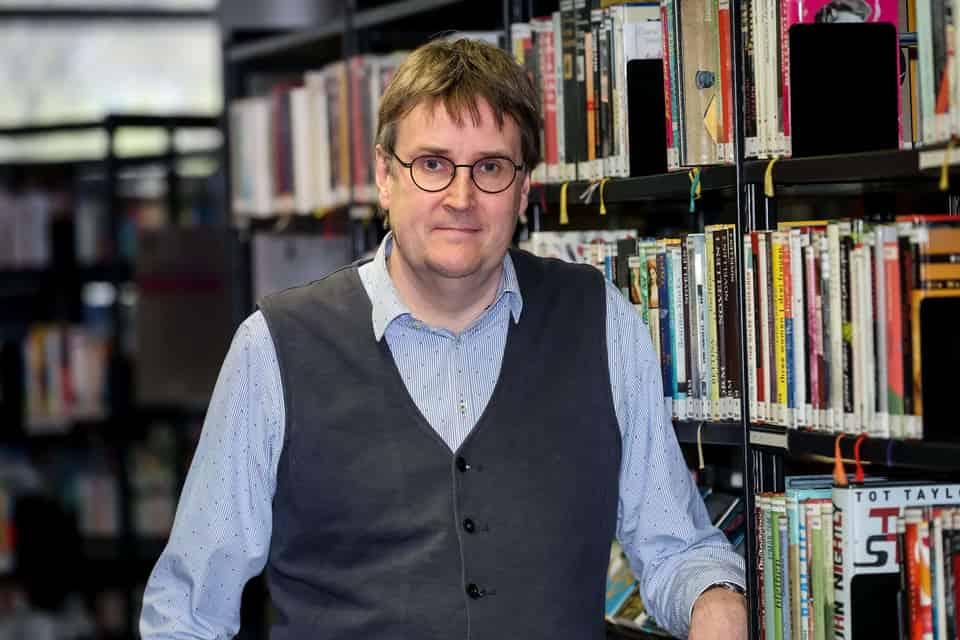
Erste erfahrungen mit der neuen anlage
Nach mehr als sechs Monaten mit der Rückgabeanlage im produktiven Betrieb haben sich die Erwartungen mehr als erfüllt. Insbesondere die geringe Geräuschentwicklung und die hohe Geschwindigkeit bei der Rücknahme und Weiterverarbeitung der zurückgegebenen Medien haben auch zunächst skeptische Kolleginnen und Kollegen überzeugt. Auch an Tagen mit sehr hohem Aufkommen, wie beispielsweise dem 1. Öffnungstag nach der Weihnachtsschließung kam es zu keinen Schlangen an der Rückgabe. Der Transport der Medien mit dem Aufzug erfolgt weitgehend störungsfrei. Die anfänglichen Probleme mit bestimmten Zeitschriftenheften, die zu Störungen im Bereich des Aufzuges führten, konnten durch eine Änderung der Sortierziele abgestellt werden. Die Kundinnen und Kunden der Bibliothek hatten mit den neuen Rückgabeautomaten überhaupt keine Probleme, so dass von Anfang an sehr wenig Unterstützungsbedarf bestand.
Durch die gut sichtbare Ampelsteuerung und den übersichtlichen Aufbau der Bedienbildschirm ist die Bedienung kinderleicht. Die frei platzierte Anlage übt gerade auf die jüngeren Nutzer:innen eine große Faszination aus und regelmäßig werden die zurückgegebenen Medien auf ihrem Weg zum Sammelbehälter mit Blicken verfolgt.
Bei einem ungeplanten Netzwerkausfall zeigte sich die Rückgabeanlage sehr stabil und ging sofort in einen Notverbuchungsbetrieb über, so dass die Kundinnen und Kunden weiterhin Medien zurückgeben konnten und auch Rückgabequittungen ausgestellt wurden. Die Rückkehr in den regulären Betrieb erfolgte ebenfalls unmittelbar und durch die auf beiden Ebenen vorhandenen Mitarbeitendenstationen konnte die Nachbearbeitung der in den Überlaufbehältern gesammelten Medien schnell und unkompliziert durchgeführt werden.
Die nur sehr selten auftretenden Störungen im Bereich der Sensoren konnten durch die Implementierung regelmäßiger Reinigungsintervalle in Form von Absaugen der Sensoren noch weiter reduziert werden. Auch die gelegentlich Auftretenden Störungen an den Rückgabestationen beispielsweise durch nicht verbundene Quittungsdrucker können mittlerweile schnell von dem im Bereich eingesetzten Personal behoben werden. Hier machte sich auch positiv bemerkbar, dass der Kundenservice von Lyngsoe bei auftretenden Fragen und Problemen immer sehr schnell mit Antworten und Lösungen bereitstand.
Insgesamt beobachten wir einen sehr stabilen und störungsfreien Betrieb. Die Rückgabeanlage ermöglicht der Bibliothek einen optimierten Personaleinsatz, so dass im Sommer 2023 eine Ausweitung der Öffnungszeiten auf den bisherigen Schließtag angedacht ist. Die Zentralbibliothek der Stadt und Landesbibliothek wird dann an sechs Tagen in der Woche geöffnet sein.
